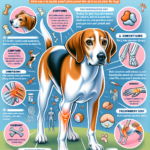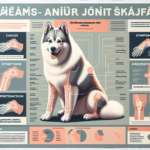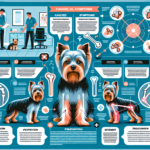American Foxhound Joint Pain: Causes, Symptoms, Prevention, and Treatment

Introduction
The American Foxhound is a breed with a rich history and a distinctive set of characteristics. Known for their exceptional hunting abilities, these dogs have been a part of American culture since the colonial era. They are medium to large-sized dogs, characterized by their long legs, sleek bodies, and keen sense of smell. American Foxhounds are known for their endurance, speed, and a melodious bay that can be heard from great distances.
While American Foxhounds are generally healthy dogs, they are not immune to certain health issues. Common concerns include ear infections, hip dysplasia, and various skin conditions. Among these, joint pain is a significant issue that can affect their quality of life. Given their active lifestyle and physical demands, maintaining joint health is crucial for this breed.
Joint health is particularly important for American Foxhounds due to their high activity levels and the physical stress they endure. Whether they are used for hunting, running, or simply as active family pets, their joints are constantly under strain. Ensuring good joint health can help them lead a more comfortable and active life.
Breed-Specific Joint Pain Risks
Genetic Predisposition
American Foxhounds have a genetic predisposition to several joint-related issues. Hip dysplasia is one of the most common conditions, where the hip joint does not fit into the hip socket properly. This can lead to arthritis and significant pain over time. Elbow dysplasia is another concern, where the elbow joint is malformed, causing lameness and discomfort. These genetic issues can be exacerbated by their active lifestyle, making early detection and management crucial.
Age-Related Risks
As American Foxhounds age, the risk of joint pain increases. The wear and tear on their joints from years of activity can lead to conditions like osteoarthritis. Typically, signs of joint pain may start to appear in middle age, around 5 to 7 years old. However, some dogs may show symptoms earlier, especially if they have a genetic predisposition to joint issues.
Activity Level and Joint Stress
American Foxhounds are known for their high energy levels and need for regular exercise. While this is beneficial for their overall health, it can also contribute to joint stress. Activities like running, jumping, and hunting put significant strain on their joints. Over time, this can lead to wear and tear, making them more susceptible to joint pain and related conditions.
Common Symptoms of Joint Pain in American Foxhounds
General Symptoms
Owners should be vigilant for common symptoms of joint pain in their American Foxhounds. These include:
- Limping or favoring one leg
- Stiffness, especially after rest
- Reluctance to move or climb stairs
- Decreased activity or playfulness
- Swelling around the joints
- Whining or showing signs of discomfort when touched
Breed-Specific Symptoms
In American Foxhounds, symptoms like a noticeable decrease in their usual high energy levels or reluctance to engage in activities they once enjoyed can be particularly telling. Given their natural inclination for activity, any significant change in their behavior should be taken seriously.
When to Consult a Vet
If you notice any of the above symptoms, it is essential to consult a veterinarian. Early diagnosis and treatment can significantly improve the quality of life for your dog. Persistent limping, severe stiffness, or any signs of pain should prompt an immediate visit to the vet.
Preventive Measures for Joint Health
Exercise Recommendations
Regular exercise is crucial for maintaining joint health in American Foxhounds. However, it is essential to balance activity to avoid overexertion. Low-impact exercises like swimming can be particularly beneficial as they provide a good workout without putting too much strain on the joints. Regular walks and controlled running sessions are also recommended.
Dietary Suggestions
A balanced diet rich in essential nutrients can support joint health. Foods high in omega-3 fatty acids, glucosamine, and chondroitin can help maintain healthy joints. Consider incorporating supplements specifically designed for joint health, but always consult your vet before making any dietary changes.
Weight Management
Maintaining a healthy weight is crucial for reducing joint stress. Excess weight can exacerbate joint issues and lead to more severe pain. Regular exercise combined with a balanced diet can help keep your American Foxhound at an optimal weight.
Early Screening and Monitoring
Regular veterinary check-ups are essential for early detection of joint issues. Screening tests like X-rays can help identify problems before they become severe. Monitoring your dog’s behavior and physical condition can also provide early warning signs of joint pain.
Treatment Options for Joint Pain
Non-Surgical Treatments
Non-surgical treatments are often the first line of defense against joint pain. These can include:
- Medications: Anti-inflammatory drugs and pain relievers can help manage symptoms.
- Physical Therapy: Exercises designed to strengthen muscles around the joints can provide relief.
- Lifestyle Adjustments: Modifying activities to reduce joint stress can be beneficial.
Surgical Options
In severe cases, surgical intervention may be necessary. Common surgeries for joint pain include:
- Hip Replacement: Replacing the damaged hip joint with an artificial one.
- Arthroscopy: A minimally invasive surgery to remove damaged tissue.
- Joint Fusion: Fusing the joint to reduce pain and improve stability.
Alternative Therapies
Alternative treatments can also provide relief for joint pain. These include:
- Acupuncture: Can help reduce pain and improve mobility.
- Hydrotherapy: Water-based exercises that reduce joint stress.
- Massage: Helps improve circulation and reduce muscle tension.
Lifestyle and Management Tips
Daily Care Routine
A consistent daily care routine can help manage joint pain. This can include:
- Regular, low-impact exercise
- A balanced diet with joint-supporting supplements
- Regular vet check-ups
- Monitoring for any changes in behavior or mobility
Modifying the Home Environment
Making your home more comfortable for a dog with joint pain can significantly improve their quality of life. Consider:
- Installing ramps to avoid stairs
- Providing orthopedic beds for better support
- Using non-slip mats to prevent falls
Long-Term Management
Long-term management strategies are essential for keeping your American Foxhound active and happy despite joint pain. These can include:
- Regular physical therapy sessions
- Consistent use of prescribed medications
- Ongoing monitoring and adjustments to their care routine
FAQs About American Foxhounds and Joint Pain
What are the early signs of joint pain in American Foxhounds?
Early signs include limping, stiffness, reluctance to move, and decreased activity levels. If you notice any of these symptoms, consult your vet for a thorough examination.
Can diet help in managing joint pain?
Yes, a balanced diet rich in omega-3 fatty acids, glucosamine, and chondroitin can support joint health. Supplements can also be beneficial but should be used under veterinary guidance.
Are there specific exercises that are better for joint health?
Low-impact exercises like swimming and controlled walking are excellent for maintaining joint health without putting too much strain on the joints.
When should I consider surgical options for my dog?
Surgical options should be considered when non-surgical treatments are no longer effective, and your dog’s quality of life is significantly affected. Consult your vet for a thorough evaluation and recommendations.
Conclusion
Maintaining joint health in American Foxhounds is crucial for their overall well-being and quality of life. By understanding the risks, recognizing the symptoms, and taking preventive measures, you can help ensure your dog remains active and comfortable. Regular veterinary check-ups, a balanced diet, and appropriate exercise are key components in managing joint health. If joint pain does occur, a range of treatment options, from medications to surgery, can provide relief. Always consult your veterinarian for personalized advice and treatment plans to keep your American Foxhound healthy and happy.




